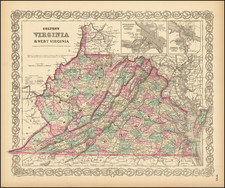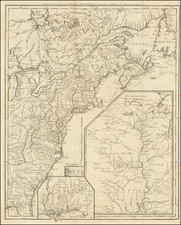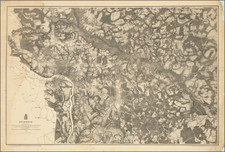Scarce example of Banastre Tarleton's plan of the Battle and Siege of Yorktown, the decisive battle of the American Revolution.
Tarleton's map was likely the source of Johann Von Ewald's manuscript plan. Ewald, however, extended his plan into Gloucester County and added his own remarks. Captain Johann von Ewald (1744-1813), was a Hessian officer who came to America in 1776 with the British military forces. Von Ewald was a participant in many of the significant battles of the war, and was with Lord Cornwallis at the surrender of Yorktown in 1781. He kept a diary of his experiences throughout the Revolutionary War, but just as importantly created numerous maps of the areas he was in, with the placement of troops and fortifications.
At bottom right on the Yorktown side are shown the headquarters of Washington and Rochambeau and the American artillery. Above and to the left are French artillery, General Lincoln, General le Marquis de la Fayette, General Siwoens (Steuben), and Clinton. To the left are the French regiments Saintonge, Soissen[nais], Deux-Ponts, and Bourbon[nais]. At the top are shown the first and second parallels, "Moors" [Moore's] House, and American and French batteries. At lower left are the French regiments Agénais, Gatinais, Touraine; the Volunteers of Saint-Simon; and a French battery. Below Yorktown is the Fusiliers' Redoubt. Also shown are the numbered regiments in Yorktown itself and the sunken ships Guadeloupe and Charon in the York River.
On the Gloucester side, numbered redoubts are visible in the town itself: No. 1, Rangers; No. 2, Legion; No.3, 80th Regiment; No. 4, unassigned. At the mouth of Sarah Creek Ewald noted, "Place where I stood when French fleet arrived before the mouth of the York River." The area above the town is labeled "Mostly cut-down woods." In front of the work on the road leading out of Gloucester are stationed French sentries. Toward the bottom are "Infantry picket," "Cavalry picket," "Corps under General Choisy," and "Hussars." At the left of the plan is "Sauls" [Seawell's] Plantation. The headquarters are shown at Seawell's Ordinary.
The map first appeared in Sir Banastre Tarleton's A History of the Campaigns of 1780 and 1781, in the Southern Provinces of North America . . ., published in London in 1787. The map was re-issued in Charles Stedman's History of the Origin, Progress and Termination of the American War (London 1794. The map covers an area approximately 3 miles square, extending from the southern tip of Gloucester and includes all of the battle positions of the two armies, in and around Yorktown. The Lines of fire from various redoubts are shown, along with sunken vessels and the ships Guadaloupe and Charon.
One of the best contemporary plans of the Siege and Battle at Yorktown.









![(American Revolution) [Original manuscript account book kept by John Agnew, Clerk of the Quarter Sessions and Justice of the Peace, Cumberland County, Pennsylvania, recording sales of supplies destined for Washington's army during the American Revolution]](https://storage.googleapis.com/raremaps/img/small/95483.jpg)
![A New Map of Virginia [Chesapeake]](https://storage.googleapis.com/raremaps/img/small/43053.jpg)


![[ Battle of Saratoga -- Multi Day Flap ] Plan of the Encampment and Position of the Army under His Excelly. Lt. General Burgoyne at Braemus Heights on Hudson's River near Stillwater, on the 20th Septr. with the Position of the Detachment &c. in the Action of the 7th of Octr. & the Position of the Army on the 8th Octr 1777. Drawn by W.C. Wilkinson Lt. 62 Regt. Asst. Engr. [with the overlaid flap]](https://storage.googleapis.com/raremaps/img/small/102532.jpg)
